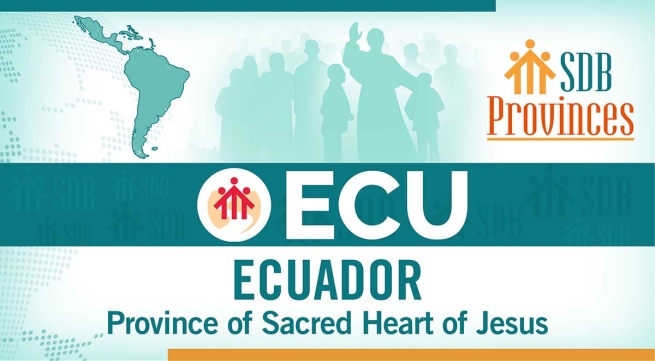In the following years, new works were founded in various cities: Don Bosco La Tola-Quito (1896), Guayaquil (1902), Indanza (1914), Méndez (1915), Macas (1924), Manabí (1927), Sucúa (1931), and Limón (1936).
A major turning point in Salesian history was the creation of the Apostolic Vicariate of Méndez and Gualaquiza in 1893, with the mission of evangelizing the indigenous Shuar people, a responsibility entrusted to the Salesian Congregation by Pope Leo XIII.
Initially, the Salesian presence in Ecuador functioned as a Vice-Province for six years. However, in 1893, it was officially established as a Province. Later, in 1912, the Ecuadorian Province was temporarily merged with the Peruvian-Bolivian Province but regained its autonomy and legal status in 1916.
137 Years of Salesian Presence in Ecuador
Over 137 years, Salesian educational and apostolic initiatives have flourished throughout Ecuador. Today, the province is engaged in various educational and pastoral settings, including:
- Oratories and youth centers
- Schools and higher education centers Parishes and sanctuaries
- Social services and missionary work among the Shuar, Achuar, Kichwa, and Afro-descendant communities
- Three publishing houses producing schoolbooks, pastoral materials, and academic publications
Salesian Personnel and Impact
The ECU Province is led by:
- 97 priests
- 10 Salesian brothers (coadjutors)
- 2 perpetually professed members
- 10 temporary professed members
- 1 novice
The Salesians operate in 23 religious communities and 8 presences managed by lay people, overseeing:
- 22 Salesian schools
- 13 parishes, including 3 sanctuaries and 13 missionary parishes in indigenous areas
- 31 oratories and youth centers
- 9 productive works, including 3 publishing houses, 2 printing presses, 3 retreat centers, a student residence, and a university with 3 branches
- 11 social service projects
In total, the ECU Province serves approximately 162,281 beneficiaries, educating 28,475 school students and 25,000 university students, with 4,098 lay collaborators contributing to Don Bosco’s mission.
Salesian Family in Ecuador
Ecuador is home to 10 groups of the Salesian Family, including:
- Salesians of Don Bosco (SDB)
- Daughters of Mary Help of Christians (FMA)
- Daughters of the Sacred Hearts of Jesus and Mary (HHSSCC)
- Volunteers of Don Bosco (VDB) Salesian Cooperators (SSCC)
- Association of Mary Help of Christians (ADMA)
- Association of Salesian Ladies (ADS)
- Daughters of the Divine Savior (HDS)
- Past Pupils of Don Bosco (EX.DB)
- Past Pupils of the FMA (EX.FMA)
Key Projects of the ECU Province
1. Support for Working and Homeless Children
The Salesian mission in Ecuador prioritizes supporting working and homeless children between ages 6 and 18 who live in vulnerable conditions. This major initiative was launched on December 8, 1980, when the Salesians adopted the "Chicos de la Calle" (Street Children) Salesian Project as a core mission, alongside their commitment to indigenous communities in the Sierra and Amazon regions.
Currently, over 4,000 beneficiaries receive support through programs in seven cities: Quito, Guayaquil, Cuenca, Ambato, Esmeraldas, Santo Domingo, and San Lorenzo.
Since 2000, the province has strengthened its national coordination efforts, aligning with state policies focused on prevention, family reintegration, and children's rights. This has led to the development of a pastoral-educational approach, structured around seven intervention areas:
- Preventive presence on the streets
- Timely reception and family reintegration
- Family and community engagement
- Schooling support Technical and vocational training
- Citizenship and social responsibility education
- Faith-based education
2. Missionary Work with Indigenous and Afro-Descendant Communities
For over 130 years, the Salesian Province of Ecuador (ECU) has served Shuar, Achuar, Andean, and Afro-descendant communities.
Through the Salesian Missionary Renewal Project, the province aims to respond to the Rector Major’s call for pastoral conversion in response to contemporary challenges.
Salesians actively work in:
- Simiatug with the Kichwa people
- Bomboiza, Yaupi, Taisha, and the Sevilla "Don Bosco" center with the Shuar people
- Wasakentsa with the Achuar people
- Various urban areas along the Coastal region with Afro-Ecuadorian communities
The Salesian Polytechnic University: A Pillar of Education
The Salesian Polytechnic University is the largest university within the Salesian Congregation, boasting:
- 25,000 students
- 30 years of history
- 6 university campuses across three locations
- 5 support centers
- 42 undergraduate programs
- 38 postgraduate (master’s) programs
- 2 doctoral programs
Most students come from middle and lower-income backgrounds, while its faculty leads 104 research groups and publishes in globally recognized scientific journals. The university ranks among Ecuador’s top five institutions.
Conclusion
For 137 years, the Salesians of Ecuador have been committed to education, evangelization, and social development, with a special focus on marginalized youth and indigenous communities. Their schools, missions, and social initiatives continue to transform thousands of lives, carrying forward Don Bosco’s dream in the heart of Latin America.
-
 Title
Title
Title
Title
-
 Title
Title
Title
Title
-
 Title
Title
Title
Title
-
 Title
Title
Title
Title
-
 Title
Title
Title
Title
-
 Title
Title
Title
Title
-
 Title
Title
Title
Title
-
 Title
Title
Title
Title
-
 Title
Title
Title
Title
-
 Title
Title
Title
Title
-
 Title
Title
Title
Title
-
 Title
Title
Title
Title
-
 Title
Title
Title
Title
-
 Title
Title
Title
Title
-
 Title
Title
Title
Title
https://www.infoans.org/en/component/k2/item/23500#sigProIda0bd4ca237


